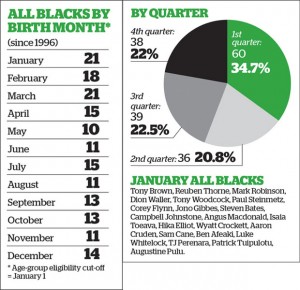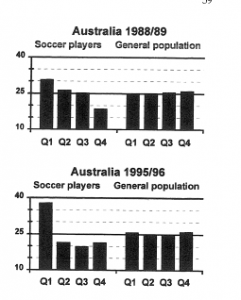All-Blacks birth month
This graphic and the accompanying story in the Herald produced a certain amount of skeptical discussion on Twitter today.
It looks a bit as though there is an effect of birth month, and the Herald backs this up with citations to Malcolm Gladwell on ice hockey.
The first question is whether there is any real evidence of a pattern. There is, though it’s not overwhelming. If you did this for random sets of 173 people, about 1 in 80 times there would be 60 or more in the same quarter (and yes, I did use actual birth frequencies rather than just treating all quarters as equal). The story also looks at the Black Caps, where evidence is a lot weaker because the numbers are smaller.
On the other hand, we are comparing to a pre-existing hypothesis here. If you asked whether the data were a better fit to equal distribution over quarters or to Gladwell’s ice-hockey statistic of a majority in the first quarter, they are a much better fit to equal distribution over quarters.
The next step is to go slightly further than Gladwell, who is not (to put it mildly) a primary source. The fact that he says there is a study showing X is good evidence that there is a study showing X, but it isn’t terribly good evidence that X is true. His books are written to communicate an idea, not to provide balanced reporting or scientific reference. The hockey analysis he quotes was the first study of the topic, not the last word.
It turns out that even for ice-hockey things are more complicated
Using publically available data of hockey players from 2000–2009, we find that the relative age effect, as described by Nolan and Howell (2010) and Gladwell (2008), is moderate for the average Canadian National Hockey League player and reverses when examining the most elite professional players (i.e. All-Star and Olympic Team rosters).
So, if you expect the ice-hockey phenomenon to show up in New Zealand, the ‘most elite professional players’, the All Blacks might be the wrong place to look.
On the other hand Rugby League in the UK does show very strong relative age effects even into the national teams — more like the 50% in first quarter that Gladwell quotes for ice hockey. Further evidence that things are more complicated comes from soccer. A paper (PDF) looking at junior and professional soccer found imbalances in date of birth, again getting weaker at higher levels. They also had an interesting natural experiment when the eligibility date changed in Australia, from January 1 to August 1.
As the graph shows, the change in eligibility date was followed by a change in birth-date distribution, but not how you might expect. An August 1 cutoff saw a stronger first-quarter peak than the January 1 cutoff.
Overall, it really does seem to be true that relative age effects have an impact on junior sports participation, and possibly even high-level professional acheivement. You still might not expect the ‘majority born in the first quarter’ effect to translate from the NHL as a whole to the All Blacks, and the data suggest it doesn’t.
Rather more important, however, are relative age effects in education. After all, there’s a roughly 99.9% chance that your child isn’t going to be an All Black, but education is pretty much inevitable. There’s similar evidence that the school-age cutoff has an effect on educational attainment, which is weaker than the sports effects, but impacts a lot more people. In Britain, where the school cutoff is September 1:
Analysis shows that approximately 6% fewer August-born children reached the expected level of attainment in the 3 core subjects at GCSE (English, mathematics and science) relative to September-born children (August born girls 55%; boys 44%; September born girls 61% boys 50%)
In New Zealand, with a March 1 cutoff, you’d expect worse average school performance for kids born on the dates the Herald story is recommending.
As with future All Blacks, the real issue here isn’t when to conceive. The real issue is that the system isn’t working as well for some people. The All Blacks (or more likely the Blues) might play better if they weren’t missing key players born in the wrong month. The education system, at least in the UK, would work better if it taught all children as well as it teaches those born in autumn. One of these matters.
Thomas Lumley (@tslumley) is Professor of Biostatistics at the University of Auckland. His research interests include semiparametric models, survey sampling, statistical computing, foundations of statistics, and whatever methodological problems his medical collaborators come up with. He also blogs at Biased and Inefficient See all posts by Thomas Lumley »


Red-shirting (holding kids back in kindergarten to give them a size and maturity advantage against their peers) has been an issue in the States so I was interested in seeing if there was any effect in NZ using the TIMMS data (Year 5 tests in maths and science).
Using the 2011 data, those kids born in the six month after the 1 Dec have an average score significantly below those born 6 months before but it’s quite minor IIRC <1/3 of a sd. (The MoE suggest a 1 June cut-off but the school and parents get to negotiate that with each other.)
I also looked at the largest cohort who were born within 365 days of one another and this cohort has got older compared to the previous 2007 TIMSS study. The actual cut-off in the TIMSS data is around 1 May.
At college, rugby has a weight based grading system rather than age based so that tends to keep the smaller (younger) kids involved and given them a chance to get any benefit out of puberty. I would think that dampens some of the age effects around getting big earlier than peers.
10 years ago
I thought about playing rugby in high school, but I was too old for the appropriate weight class.
10 years ago
Yes the pattern does appear to get weaker at higher levels with older players. However, an interesting pattern is emerging in New Zealand age group rugby teams. One example is from the New Zealand Under 20 rugby team of 2011. In this squad, 10 of the 26 players were born in January or February. Put another way roughly 38% were born in the first 16% of the year. Only 3 out of 26 players were born in the second half of the year (that’s about 11.5% of the team). Similar results can be observed in other teams.
I’d say you could make a reasonable argument that a player may have more chance of making one of these teams if they are a whole year younger (Under 19 on January 1 with a January or February birthday) as opposed to being Under 20 with a birthday in the last three months of the year.
Not surprisingly similar results can be seen elsewhere. The Spanish Under 20 football (soccer) team of 2011 had 9 out of 21 players born in January or February with only 2 out of 21 born from July to December.
The pattern has long been noted in age-group teams. As there is now an increased focus on developing age-group teams in professional sports, it will be interested to see if the patterns become more noticeable in full national teams in the near future.
10 years ago
Age grouping is really problematic because it picks out the kids who are early developers (some who may already have done all their growing). However, the early developers tend to have it easy so when they finally meet equal competition they don’t like playing anymore because it’s too hard.
The late developers, who grow big in puberty, are often the talent that you want to capture because they’ve hung in there whiles it’s been challenging and that’s the nuggety attribute you want in elite sport.
I know Americans complain “that everyone gets a certificate” but if it keeps the little kid going until he hits puberty and grows into a giant then it’s worth it.
10 years ago
I was born in February and I’m not an All Black, so it can’t be true. Go figure :P
10 years ago